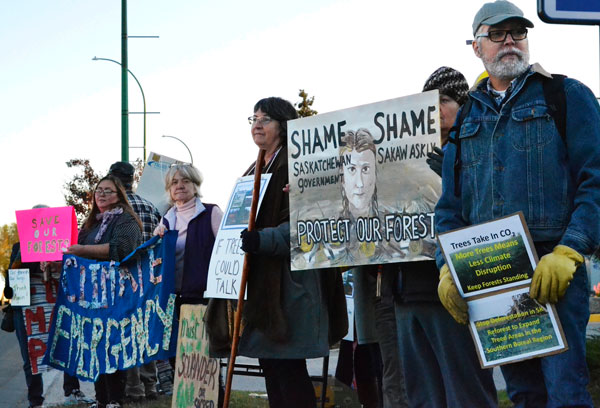
“I don’t want to be one of those people in my generation who turned the blind eye.”
– Val Drummond
A coalition of three groups protested a Sakâw Askiy Management meeting on Wednesday evening asking for changes to forestry practices in central Saskatchewan.
Sakâw Askiy holds the harvesting license for the Prince Albert forest management area. It’s monitored by the provincial government.
The corporation released a 20-year plan in 2018 and held a public consultation at the Coronet Hotel on Wednesday for its annual plan.
Sakâw Askiy harvests wood for seven shareholders. Five of them are forestry companies and two are First Nations.
The Prince Albert chapter of the Council of Canadians, Renewable Power Intelligent Choice and Protect our Forest are raising concerns about the millions of hectares Sakâw Askiy plans to cut down.
Val Drummond is a member of both Renewable Power Intelligent Choice and Protect our Forest.
“We need to rethink how we approach forests and forestry. I’m not saying we can’t harvest, but we need to do it differently,” she said in an interview.
Drummond said she’s mostly concerned about the practice’s impact on climate change.
She referenced information from the Government of Canada, which says Saskatchewan’s greenhouse gas emissions per capita are the highest in the country.
She said she felt the need to protest because Saskatchewan residents aren’t aware of the harm being done to the boreal forest.
Drummond was one of about 15 people who stood on the side of Second Avenue West holding signs reading ‘If trees could talk,’ ‘Save our forest,’ and ‘Stop clearcutting now.’
Several drivers honked their horns as they went past the group.
After protesting outside for about an hour, the coalition came into the Sakâw Askiy consultation. They placed their signs on chairs around the room.
The meeting was meant for the public to have one-on-one conversations with members of Sakâw Askiy and government representatives, but turned into a group conversation.
Drummond was one of the protesters who made an emotional speech.
“I’ve reached a point where I’ve just said ‘No.’ I don’t want to be one of those people in my generation who turned the blind eye,” she said.
The coalition is calling for a temporary ban on clearcutting, but Sakâw Askiy General Manager Diane Roddy said they’re not clearcutting nor deforesting.
Roddy said they harvest in clusters. They leave an average of nine per cent of the trees per cluster, but Drummond questioned that number in her speech.
“If I could correct one misunderstanding that people have today, it’s (that) harvesting is not deforestation,” said Roddy.
“It’s the start of a new forest, and what we do is we harvest less than one per cent of the forest that’s out there.”
However, Roddy said she was happy the group came to express their concerns.
“People have a conflict because they have different information and I think we’ve got a good story to tell, but they also have a perspective that we need to hear,” she said.

Another concern the group raised is that the harvesting is impacting Indigenous culture, which Priscilla Settee spoke to at the meeting. She’s a professor at the University of Saskatchewan.
“It’s Indigenous knowledge that’s going to save this planet,” she said. “This is the type of knowledge that all of you Western-trained scientists need to be listening to because this is knowledge that has sustained our north.”
“There’s no guarantee that my grandchildren will even have a planet to live on,” said Settee, emphasizing that people need to think beyond the money they’re making.
Protesters voiced they don’t fault Sakâw Askiy because it’s doing what the provincial government allows.
Government of Saskatchewan Area Forester Chris Brown attended the meeting. Protesters said they don’t blame him either because decisions are resting on higher positions in the Ministry of Environment.
For most of the meeting, Brown sat quietly taking notes. He assured the group he would report their concerns back to the ministry.
The Ministry of Environment responded to these concerns in an emailed statement. It said Saskatchewan’s boreal forest is constantly changing, relying on natural disturbances such as wildfires and insects for thousands of years. Because of this, harvesting is used to emulate these disturbances in areas where a wildfire is not feasible.
“Overall, 95 per cent of harvested forest areas in Saskatchewan have been successfully regenerated. If renewal is not initially successful, companies are required to go back and take the necessary steps to ensure they meet the standards for renewal. The total area of forest in Saskatchewan is not decreasing,” read the statement.
In regards to climate change, the ministry referenced Saskatchewan’s strategy called Prairie Resilience.
“Saskatchewan has 34.3 million hectares of boreal forest, with about 16,000 hectares harvested annually on average, making the impact of harvesting on the forest’s overall carbon sequestration potential very small.”
Gord Vaadeland, Executive Director of Canadian Parks and Wilderness Society (CPAWS) of Saskatchewan, was unable to attend the meeting.
He wrote a blog post that echoed a topic of brief conversation at the end of the meeting—that there’s a conflict between money and other personal values.
“To arrive at a solution, we need to acknowledge what this discussion is really about: the competing needs and interests of the humans involved and which of these interests should be given priority,” he said in the post.
He explained that foresting companies are focused more on economics and those who are opposing are concerned about their personal values, such as their spirituality and culture.
Oct. 4, 2019 – This story has been updated to include a response from the Government of Saskatchewan Ministry of Environment.

